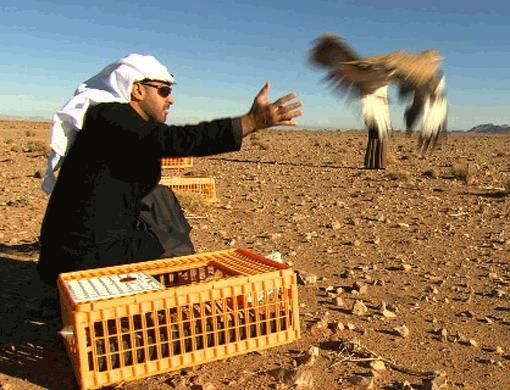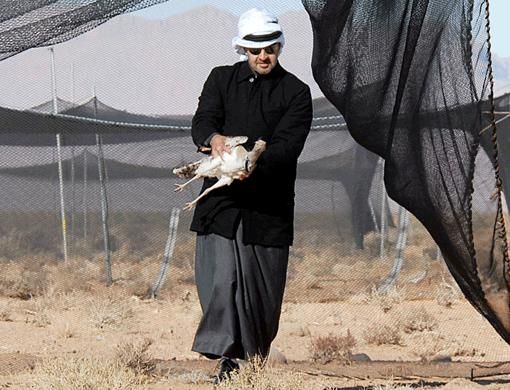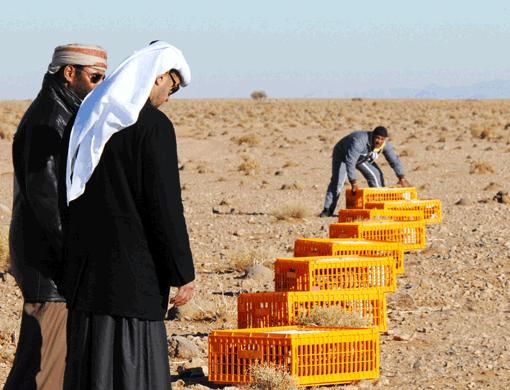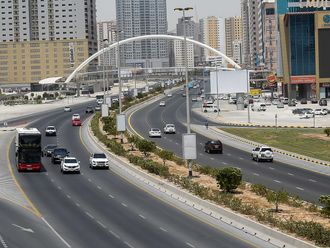Abu Dhabi: In line with the UAE's strategic efforts to increase the number of houbaras in the wild, General Shaikh Mohammad bin Zayed Al Nahyan, Abu Dhabi Crown Prince and Deputy Supreme Commander of the UAE Armed Forces, has participated in the release of more than 5,000 North African houbaras.
General Shaikh Mohammad Bin Zayed participated in the event which happened in an area of about 300km inside the eastern desert of Morocco.
General Shaikh Mohammad said: "This release of the houbaras in North Africa was necessary to meet the continuous decline of houbara numbers due to the destruction of their wintering and breeding habitat, over-trapping and over-hunting in addition to illegal trade, all of which require insistent steps to restore a healthy houbara population in the wild."
The released houbaras had been bred in captivity at the Emirates Centre for Wildlife Propagation (ECWP) in Missour, Morocco.
This release is considered to be the largest reintroduction of endangered species into the wild so far.
The houbara bustard, the species that has been reintroduced has been seriously threatened by a combination of detrimental factors as well as habitat loss.
Conservation measures
The Abu Dhabi Government has put in a great deal of effort to conserve the houbaras by building a sound scientific knowledge base about the bird and also by initiating sound management and conservation measures.
Efforts to conserve the houbaras started as early as 1977, when the late Shaikh Zayed Bin Sultan Al Nahyan directed that Al Ain Zoo begin a breeding programme for the Asian houbara bustard, even before the population reached "vulnerable" status on the endangered list.
In 1982, the first captive chick saw daylight in the UAE. In 1989, the National Avian Research Centre (NARC) which is currently spearheading maximum conservation efforts was founded and later incorporated under the Environment Agency-Abu Dhabi.
"We are very excited to have helped increase the houbara population in the wild. The UAE is committed to restoring an unlimited houbara population in the wild," said Shaikh Mohammad.
He noted that the integrated programme set by the UAE, in which the ECWP is participating has made tremendous progress and has already succeeded in creating a self-sustaining captive houbara population.
Despite the intense challenges of breeding this shy bird in captivity, the UAE is on target to meet its ambitious goal of producing 5,000 birds per year.
About 35 per cent of the released houbaras were fitted by satellite transmitter to track their movement. Birds chosen to be released were selected from a group of chicks produced by the centre based on specific criteria.
Crucial: Movements tracked
The centre's breeding complex is the headquarters of a vast network of specialised stations distributed over 40,000 square km in eastern Morocco.
The integrated, state-of-the-art facilities use the latest scientific innovations to breed, acclimatise and reintroduce the houbaras into the wild.
After release, their movements are closely tracked and their behaviour is studied in their natural habitat. One of the project's successes is that it locally grows all the food required by the houbara population.
Since the ECWP's primary objective is to restore a sustainable wild houbara population, tracking the released birds and monitoring their behaviour in their natural habitat is crucial.
In studying the houbara's efforts to survive, ECWP scientists monitor everything from weather systems to vegetation and wildlife in the release areas.















